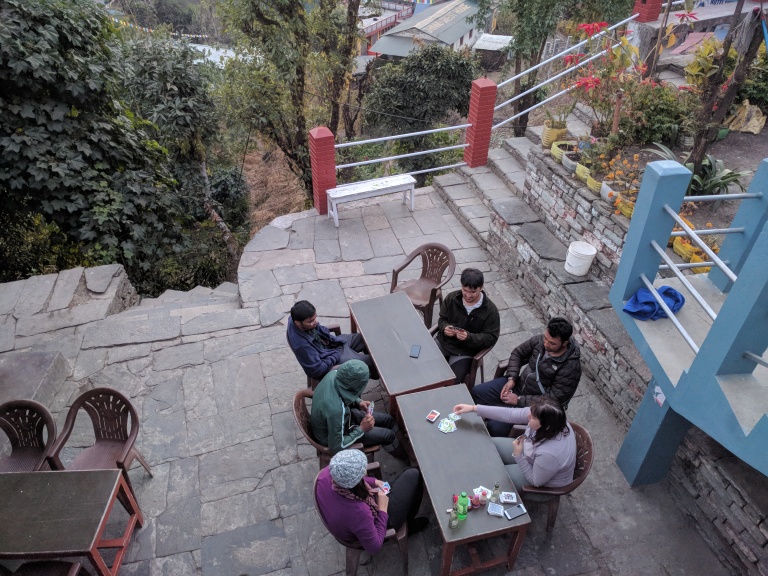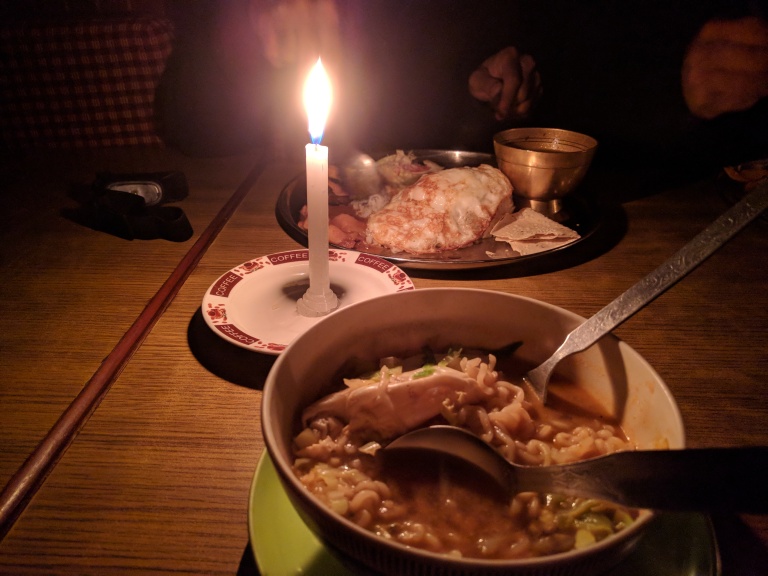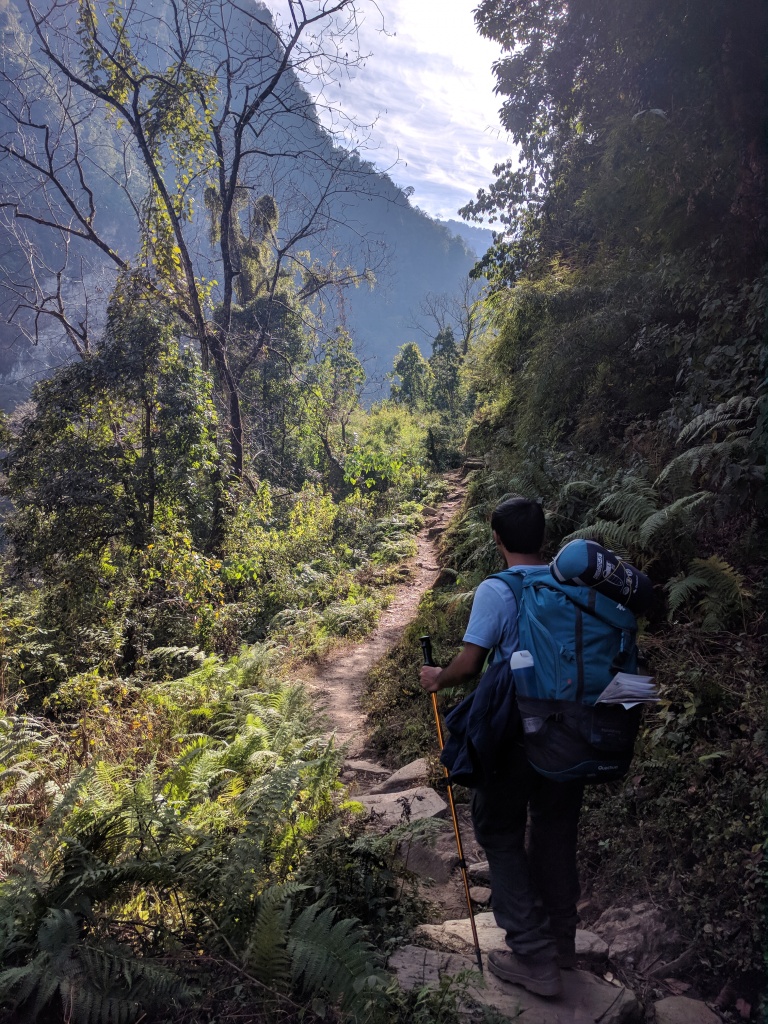
Our cab floated in the Pokhara valley, with the Maruti 800 engine smelling the dust laden roads and then coughing it away on every hole it bumped into. The shrubs along the road were heavy with soot and dust – it appeared nature had taken a beating in the mountains.
“If any money is allocated for public works, barely anything trickles down”, the driver remarked, visibly upset.
After the royal massacre, politics in Nepal has been in a constant state of flux, consequently affecting public administration. It also doesn’t help when the economy is so dependent on remittances and foreign aid for survival. However, as we slowly drifted away from the bulging urban centers, on the trail of the fish tail mountain, our faith in Nepal’s beauty was rekindled.
Rohan’s second fling at the mountains had now begun, a trip for which he had started preparing for two months in advance, running brisk laps around Shivaji Park in a stoic demonstration of human tenacity. If there was anyone fit to do this trek, that person was him. Lugged on his back was a 60 L blue coloured backpack, whose size covered the entire length of his back and then some more. The contents inside were neatly packed, covering all eventualities for the road ahead – a stash of dates, snickers, 4 layers of warm clothes, a hat, gators and a sleeping bag. His excitement had begun boiling over at the airport itself, curious to get the first glimpse of the mountains, but furious by the fact that he did not get a window seat on the flight “We came so early at the airport, yet did not get a window” he went about cribbing. Thankfully, the spectacular snow clad peaks had sobered his disappointment.
The trek did not earnestly start until we reached Ghandruk, a village nestled on the hilly slopes of the Annapurna sanctuary. It faced north, bowing to the encompassing presence of South Annapurna and the maverick Fish tail. The stony alleys of Ghandruk were lined by a contrast of near empty concrete lodges and traditional Gurung homes. Tourists prefer not to travel to Nepal in the middle of winter, but that made it just perfect for us – we had the whole village to choose from.
Rohan selected a room at the very top of a three storey lodge, which had a giant terrace adjacent to it. We were like kids, possessed of a childish greed for the mountains, wanting to never lose sight of them, day or night. Early morning, as the sun grew over the mountains, we ventured out in the dim light, wanting to see them shimmering in their golden crowns. The air was cold, but the spectacle was worth every freezing molecule that entered our bones. Slowly the sun peered into our room, and filled it with warmth. It was so pleasant that we could have lingered at our lodge till the kindness of the sun lasted, but there was a schedule to be followed if we wanted to make it to ABC and back.
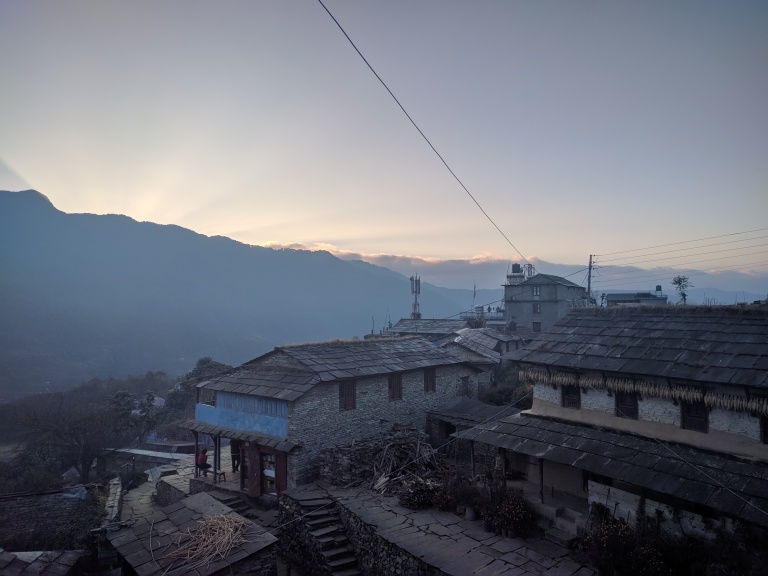
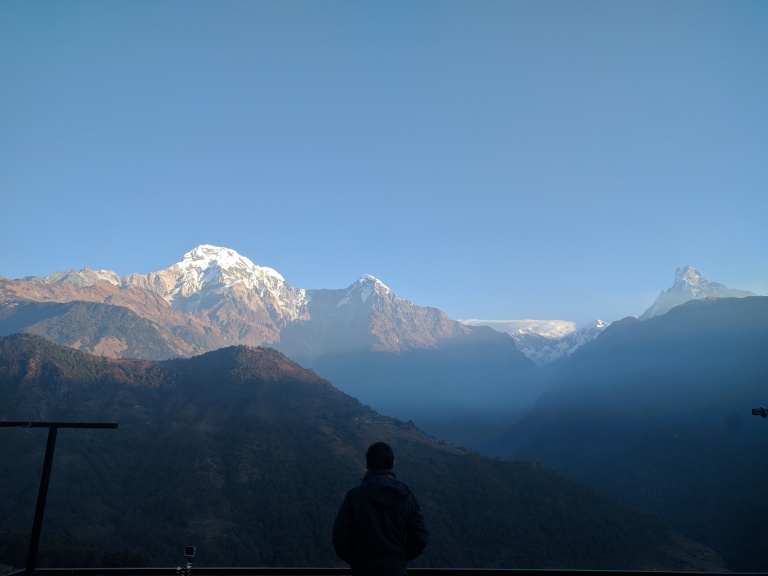
Catalyzed by the deep mountain air, Rohan led through the high hills and the wavy bridges, taking a brief pause to catch a breath in an odd shop or some vantage point that met his way. The tea houses looked on, watching us pass and then disappear, making a note of those who have gone by. The locals were jolly, and always forthcoming for help
“How far is the next village?” I asked a lady shopkeeper
She looked oddly at my legs and then laughingly remarked, “You have long legs, for you only 45 mins, for me 1 hr and and maybe 15 mins!”
Up and up we went, and then down again to our utter disdain, meeting groups of trekkers resting under the shade, and companies of porters who carried abnormal amounts of load – anywhere between 20 to 30 kilos, quite disproportionate to their own sizes. We met Nepalese folk that knew about Mumbai, of Ulhasnagar and Thane. We passed a Bengali group chanting “Udi baba!”, gasping for air, and then delighted to have accomplished a hard climb. There were some who were going down, asking for directions in the fading light, on a relentless march from ABC, covering nearly 40 kms in just under a day.
Every day the landscape changed, the open hills of Chomrong and Sinuwa gave way to the forests of Bamboo and Dovan. The harsh yellows that caused boils on Rohan’s skin, now were replaced by a filtered pleasant green, as the trees added another dimension to the trail, full of langoors and foxes. Once in a while, the canopy would open up, with views of the Fish tail mountain which appeared closer and closer, as the Modi Khola thundered down below, whisking away all the glacier melt into the plains.
Our push from Chomrong to Himalaya was tiresome, almost unending, as I hoped to see civilization at the end of every blind bend. It was evening and shadows began taking over half the valley, becoming deeper, and the colours mellowed down. The 10 kilo backpack seemed twenty, and more with every step up. There were trekkers still way down below, at least an hour behind us, would they go back? The trail was well marked, but these were not the forests in the lower hills, they were dense and dark.

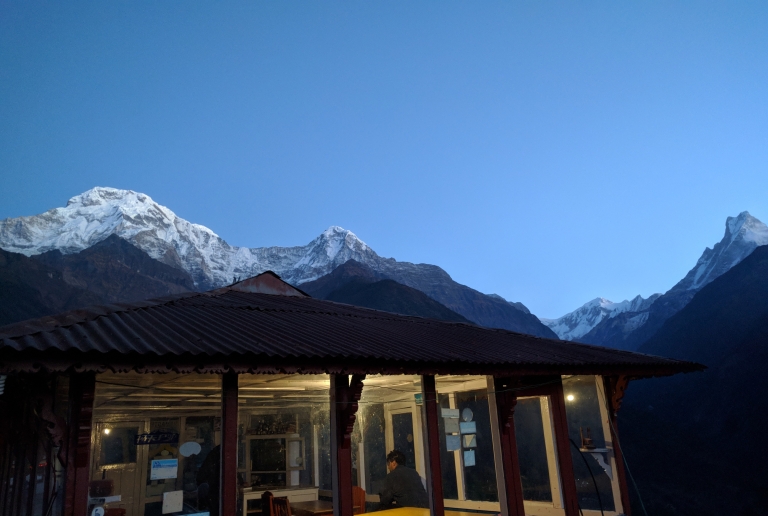
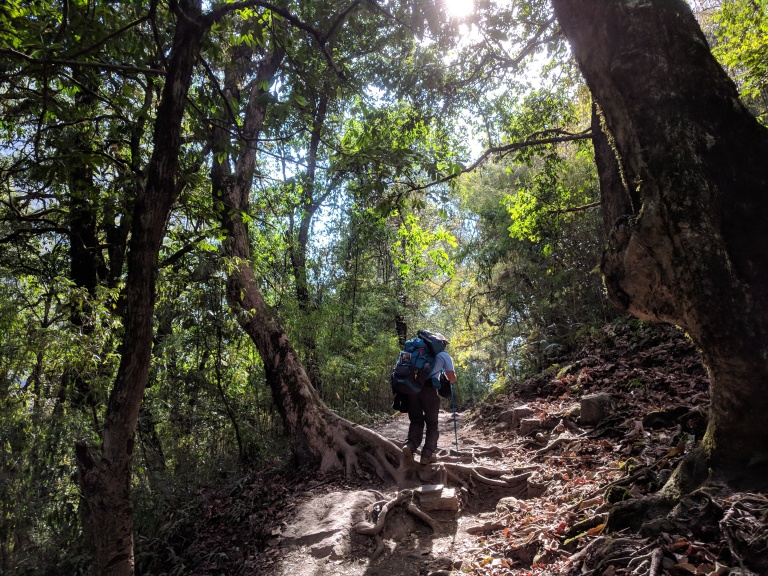
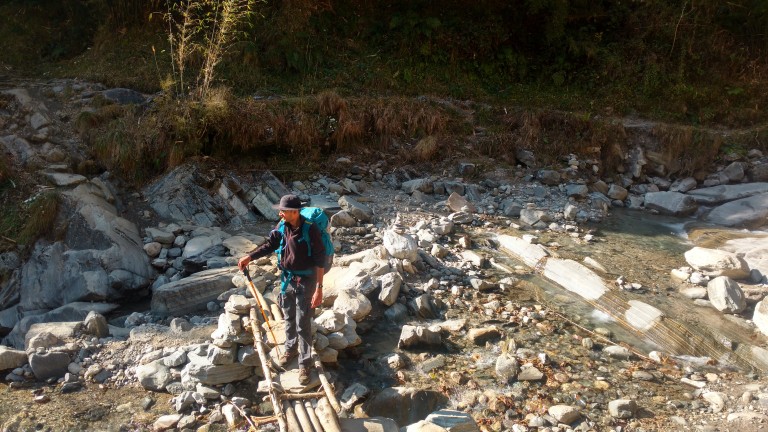
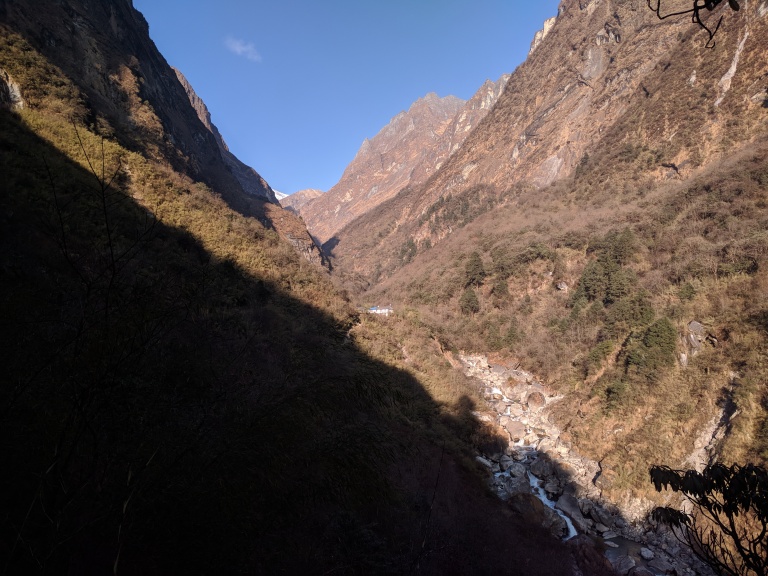
The tea houses were a refuge in all the wilderness, and our only taste of civilization. We could spot them from far off on our trail, as a blue-white dot in a small clearing among the dense forests of the valley. And they were always brimming with stories to tell, about the steely mountaineers who happened to scale fish tail, only to return back just before reaching the summit, and the times when it snowed so bad that the trail was closed for days. The winter cold prompted everyone to be indoors, but the brave and the lonesome would continue to soak in the mountains, having their last conversations with the dying sun.
We were sitting on a bench at the Himalaya tea house, it was almost dark and very very cold. A girl passed us carrying a set of clothes. She had come from Bangalore and we had met her earlier on the trail.
“So what made you come to ABC?” I asked
“I never planned to trek, just came her to escape from my parents! Met up with a Chinese guy in Pokhara, who was planning a trek and I just tagged along” she replied
She hauled her clothes, bent over a small pipe that carried water from the mountains higher up, and began swishing and banging. We couldn’t imagine putting our hands or even touching a droplet of water, and the lady was simply thrashing the elements.
“Why on earth would you wash your clothes in such cold?” I questioned, as she walked towards us, asking for help to wring her shirt dry.
“There are times when one could not bear their own stink!” she replied
–
The kitchen kept on singing aloud – whistles of the pressure cooker blowing, fried eggs cracking, the rattling of the wok and the chatter of the kitchen staff – hard at work to appease the grand appetites that all the trekkers had built up. Most travelers preferred hanging out in the warm dining hall, turning it into a hub of commotion. Stories flowed from one table to the other, enchanting those who were yet to be at the top. On our stay at Himalaya, we had the company of a helicopter pilot who used to fly ABC to and fro –
“It takes 18 mins to fly up to the base camp and 21 mins to come down” filling everyone with mixed emotions, almost ridiculing the effort that most of us had put in. But how come these helicopter folk are travelers, if they don’t travel at all?
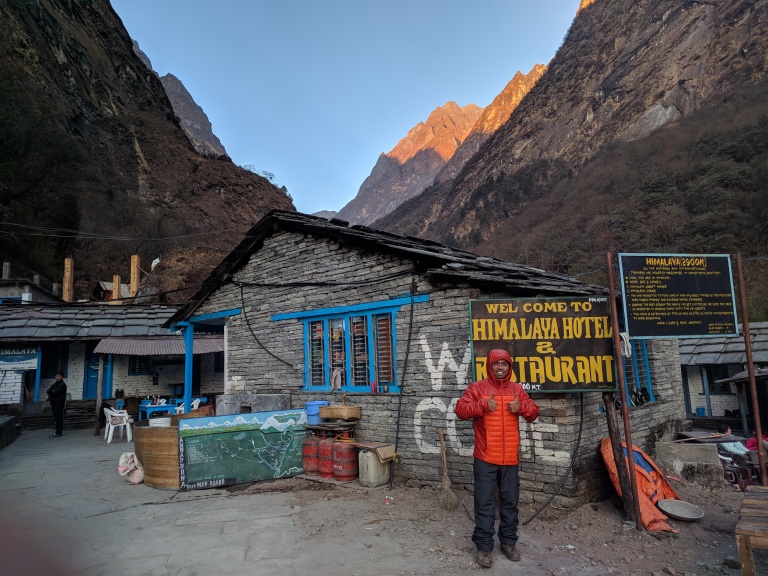
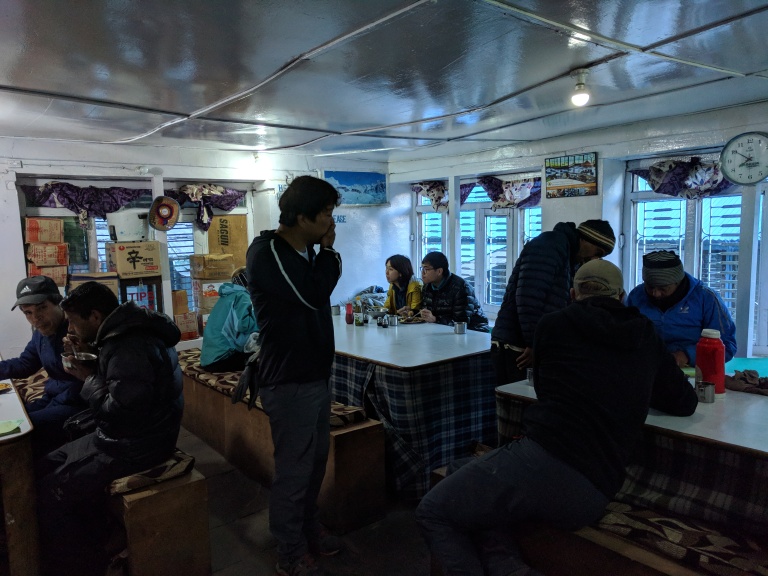
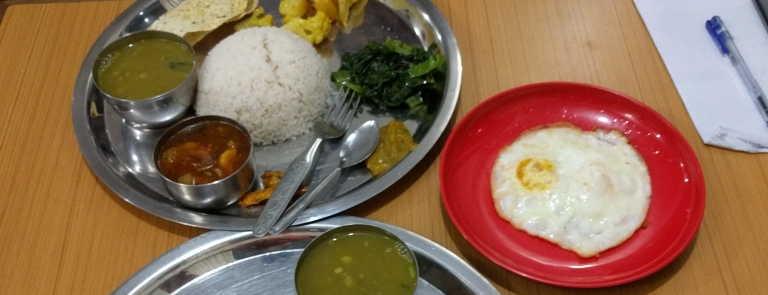
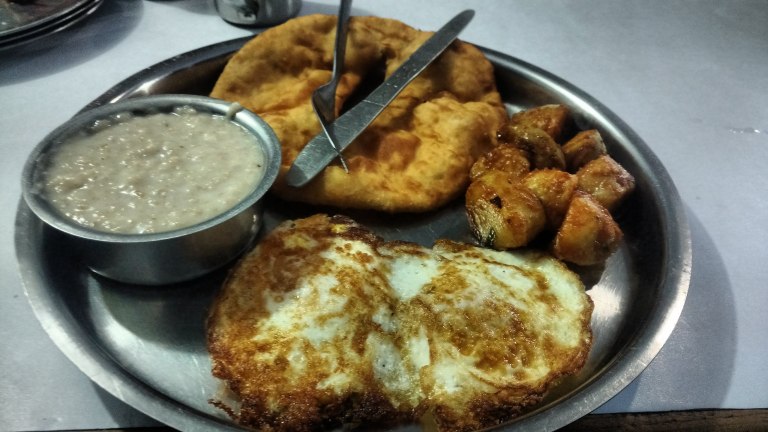
Rohan had a palpable fear of heights, anything with steep slopes alarmed him so much that he would stand far away from a ledge. In one of the treks from the western ghats, having camped to see the sunset, he refused to get anywhere near the “kada”, preferring to sit a good 10 feet away. But this fallacy drove him to conquer heights, “Let’s do Stok Kangri”, he would say, the highest trekkable peak in India. On the last stretch towards ABC, in a land without trees, thin air and sweeping view of the mountains, he was sprinting like he belonged there, and despite the altitude, going at a pace that I could not match. He wouldn’t eat much, happy with a small bowl of porridge, and some honey, eager to get on. What also drove him was the fear of not finding accommodation at the top, “What if there are no rooms for us?” And so we covered distances quite fast – gaining an elevation of 1200 metres, reaching ABC in half a day.
The annapurna base camp almost looked like a Colosseum surrounded by huge mountains on all its sides. It was easy for anyone to get intimidated by their sheer size, we were already 4000 metres high and then these ones were another 4000 metres straight up, pushing the very fabric of the skies. Maurice Herzog, in his account while scaling Annapurna called it “A diaphanous landscape, this quintessence of purity–these were not the mountains I knew: they were the mountains of my dreams.”
Around us, it was a composition of extremes, the skies were pristine and crisp, full of the deepest blue that was made, the glacial valleys eroded through the mountains, cutting gorges – almost like an abyss right next to the camp, the peaks that appeared boundless, and the cold which obliterated any remnants of warmth instantaneously.
While we were at the base camp, we witnessed three visions of a lifetime. As the evening progressed, the fish tail mountain burnt with a spectacular crimson red fury; then later in the night, our heads throbbed due to the altitude, but the Annapurna gleamed in the soft light of the moon and the stars; and finally in the morning, both the Annapurna and Fish Tail were flowing with gold. When we set out from Mumbai, we never expected such a show, but isn’t this the miracle of travel? to experience the unexpected?
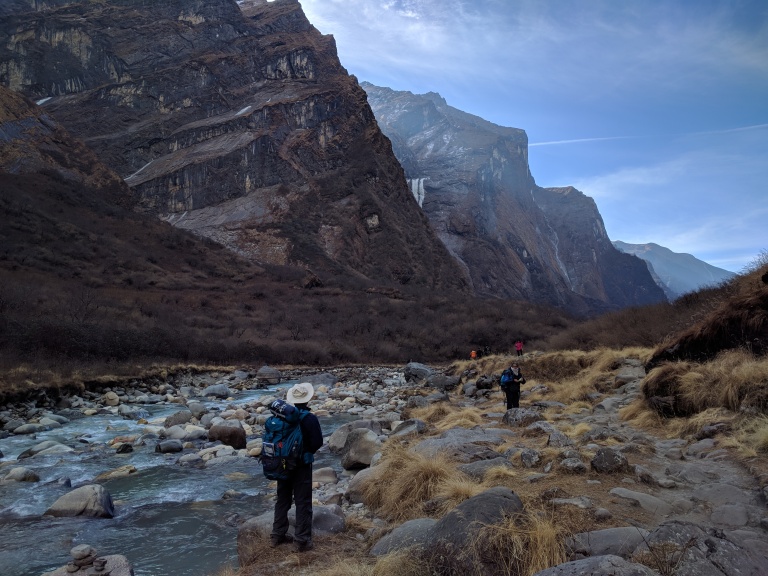
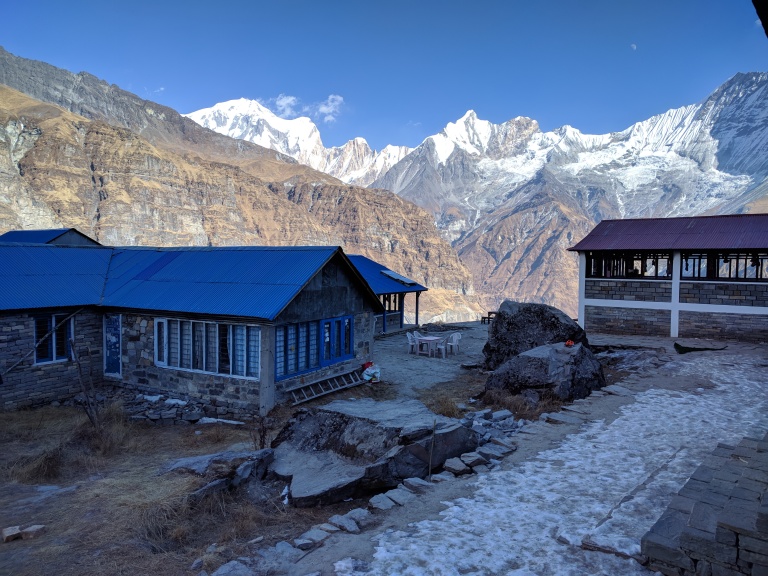


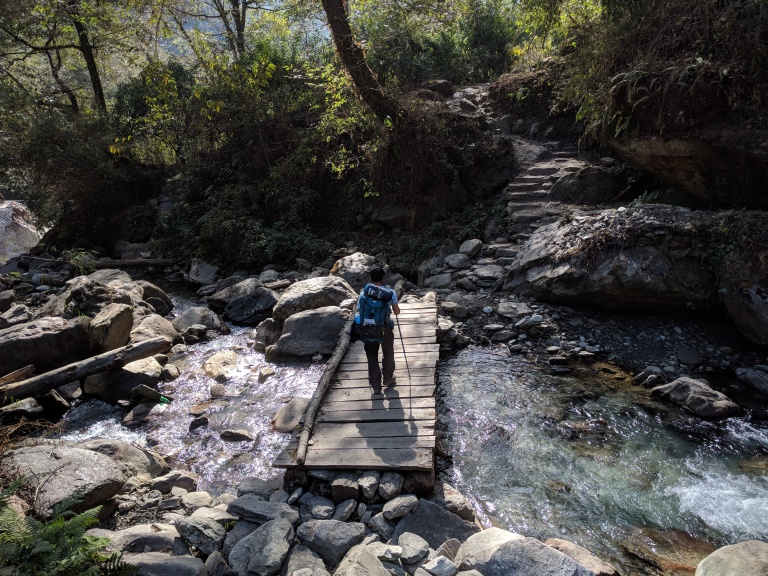
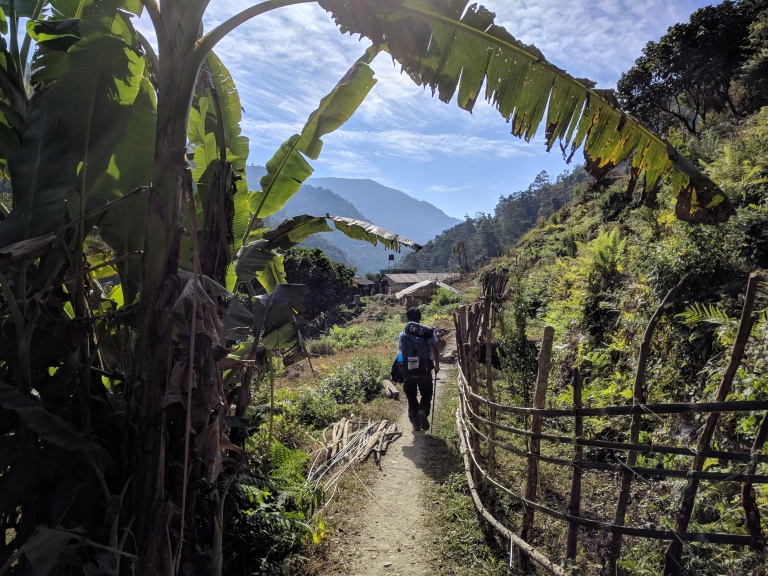
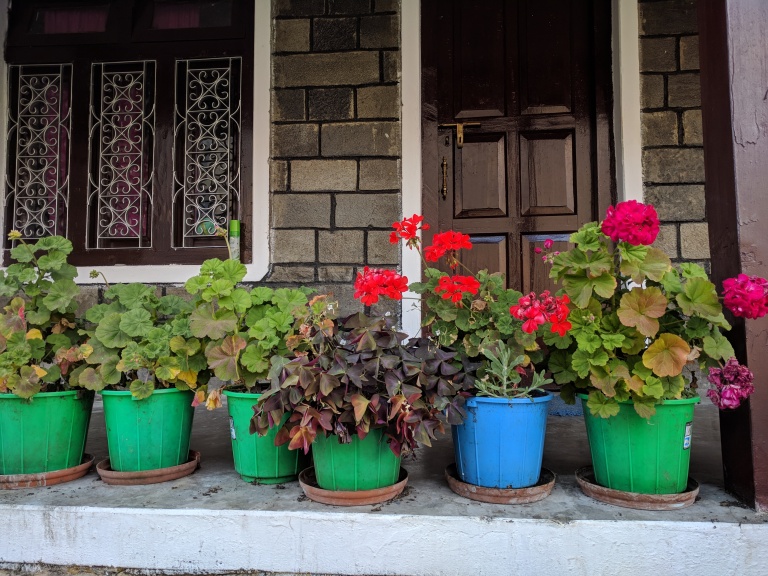
Back on the streets in Pokhara, everyone was setting up for the new year, it was one big party with stalls selling tons of food and drink. The glitz and the shining lights were in total contrast to the humble trail high up in the mountains. The whole street had transformed into a carnival, with swathes of crowd that would move in either direction, indulging themselves in booze, dance, music, performances, satiating all their thirst for excitement and entertainment.
But underneath we knew how Pokhara was like. While it had taken this form on new year, and perhaps out of necessity, for us it still remained that quaint little town besides the lake, a hub for the trekker community and a place where the folk were kind and open.

The End
In one of the stays at Jhinu, our hostess was a plump lady, happy go lucky, as anyone can be. There was no electricity that night, somewhere the electric poles had fallen over. But she would just go about joking everywhere with the staff and the guides, like nothing has happened. In the yard, we were going on with a game of cards, when one of the guides went over at the counter.
“Please give me the menu” asked the guide. He had large spectacles, with calm eyes that searched around the counter.
“Aap menu leke jaoge, but at the end you will order daal bhat, then what’s the point?” She joked around, gaily.
A little later Rohan came along, and began searching the menu. It was late evening, and he had trouble looking at the letters. The Korean noodle soup, which was my favorite, was too spicy for his taste. After running some complex calculations in his head, like he usually does, he finally ordered daal bhat. The lady started giggling – she was clearly vindicated.
Later in the night, it was still dark and power-less, but the dining hall was lit by candles and their soft light, producing a unique glow off the wooden furniture. The cold was not too treacherous and the food was warm and comforting. I was the first to get my Korean noodle soup, and then there was a big crash and a clatter! The lady innkeeper had gone down, tripped over, missing a bin in the darkness. Just like the jolly lady she was, she quickly flipped into an irate woman hurtling volleys of abuses at her own luck, then the food, and finally towards the boy who kept the bin in her path
